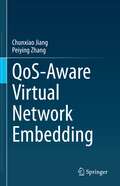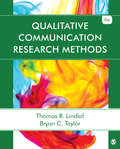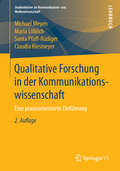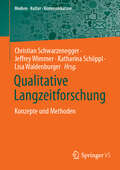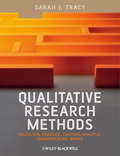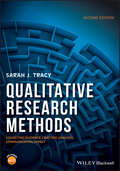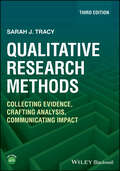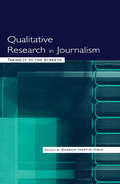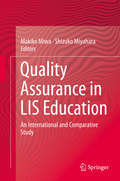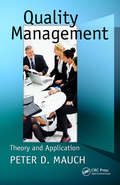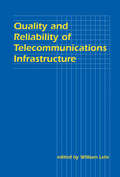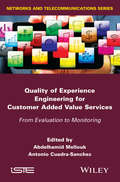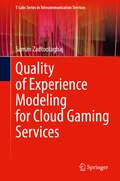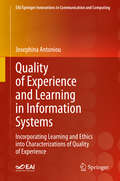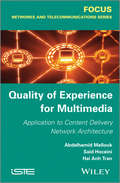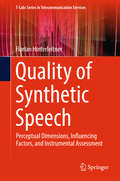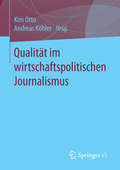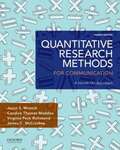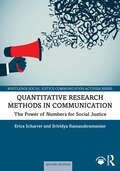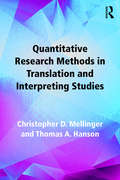- Table View
- List View
QoS-Aware Virtual Network Embedding
by Chunxiao Jiang Peiying ZhangAs an important future network architecture, virtual network architecture has received extensive attention. Virtual network embedding (VNE) is one of the core services of network virtualization (NV). It provides solutions for various network applications from the perspective of virtual network resource allocation. The Internet aims to provide global users with comprehensive coverage. The network function requests of hundreds of millions of end users have brought great pressure to the underlying network architecture. VNE algorithm can provide effective support for the reasonable and efficient allocation of network resources, so as to alleviate the pressure off the Internet. At present, a distinctive feature of the Internet environment is that the quality of service (QoS) requirements of users are differentiated. Different regions, different times, and different users have different network function requirements. Therefore, network resources need to be reasonably allocated according to users' QoS requirements to avoid the waste of network resources. In this book, based on the analysis of the principle of VNE algorithm, we provide a VNE scheme for users with differentiated QoS requirements. We summarize the common user requirements into four categories: security awareness, service awareness, energy awareness, and load balance, and then introduce the specific implementation methods of various differentiated QoS algorithms. This book provides a variety of VNE solutions, including VNE algorithms for single physical domain, VNE algorithms for across multiple physical domains, VNE algorithms based on heuristic method, and VNE algorithms based on machine learning method.
Qualitative Communication Research Methods
by Thomas R. Lindlof Bryan C. TaylorQualitative Communication Research Methods, Fourth Edition introduces you to qualitative research in speech and mass communication. Award-winning scholars and authors Thomas R. Lindlof and Bryan C. Taylor guide you through every step of the qualitative process, from developing research topics and questions through writing a final report. You are given numerous examples of work in the field to illustrate how studies are designed, carried out, written, evaluated, and related to theory. In addition to covering the theories and methods currently used in qualitative communication research, the authors also discuss important trends influencing the future of that research, helping you make informed judgments about the significance and consequences of recent trends. New to the Fourth Edition: A new chapter titled “The Diversity of Qualitative Research in Communication Subfields” provides readers with a complete guide to the field’s distinctive subfields and enables you to identify the research agenda that best represents your own interests.Two rising subfields— Political Communication and Communication Activism— have been added, resulting in 13 subfields covered. Two major phases of data analysis have been split into separate chapters, enabling you to concentrate on the initial steps of analysis before moving on to the interpretation phase of analysis. Discussions of important intellectual and institutional trends currently reshaping the landscape of qualitative research, including Materialist Theory, Big Data, and Open-Access publishing, provide you with cutting-edge knowledge and skills that affect what you study and how you study it. An analysis of new developments in media and technology shows you how social media networks and other digital platforms are not only topics of research, but also the means for collecting and analyzing data.
Qualitative Communication Research Methods (Fourth Edition)
by Thomas R. Lindlof Bryan C. TaylorQualitative Communication Research Methods, Fourth Edition introduces you to qualitative research in speech and mass communication. Award-winning scholars and authors Thomas R. Lindlof and Bryan C. Taylor guide you through every step of the qualitative process, from developing research topics and questions through writing a final report. You are given numerous examples of work in the field to illustrate how studies are designed, carried out, written, evaluated, and related to theory. In addition to covering the theories and methods currently used in qualitative communication research, the authors also discuss important trends influencing the future of that research, helping you make informed judgments about the significance and consequences of recent trends.
Qualitative Forschung in der Kommunikationswissenschaft: Eine Praxisorientierte Einführung (Studienbücher Zur Kommunikations- Und Medienwissenschaft Ser.)
by Michael Meyen Claudia Riesmeyer Maria Löblich Senta Pfaff-RüdigerDas Lehrbuch versteht sich als Anleitung zum Forschen: Wo lassen sich qualitative Methoden in der Kommunikationswissenschaft gewinnbringend einsetzen? Wie muss eine Untersuchung aufgebaut werden und wie werden Befragte oder Texte so ausgewählt, dass man am Ende verallgemeinern kann? Wie konstruiere ich einen Interview-Leitfaden und was muss ich beachten, damit eine Gruppendiskussion oder eine Beobachtung wirklich funktionieren? Befrage ich offline oder online und was kann ich tun, damit ich nicht in einem Materialberg untergehe? Mit zahlreichen Beispielen aus der Forschungspraxis.
Qualitative Langzeitforschung: Konzepte und Methoden (Medien • Kultur • Kommunikation)
by Jeffrey Wimmer Christian Schwarzenegger Lisa Waldenburger Katharina SchöpplQualitative Langzeitforschung ist in Zeiten tiefgreifender gesellschaftlicher und medialer Wandlungsprozesse von essenzieller Bedeutung Der Sammelband adressieret zentrale methodologische und methodische Fragestellungen und zeigt auf, wie den vielfältigen Herausforderungen begegnet werden kann. Insgesamt versteht er sich als ein ‚Kaleidoskop an Lösungsansätzen und Innovationen, welches Forschenden, die qualitativ im Längsschnitt arbeiten, als diskursive Hilfestellung dienen soll.
Qualitative Research Methods
by Sarah J. TracyQualitative Research Methods is a comprehensive, all-inclusive resource for the theory and practice of qualitative/ethnographic research methodology.Serves as a "how-to" guide for qualitative/ethnographic research, detailing how to design a project, conduct interviews and focus groups, interpret and analyze data, and represent it in a compelling mannerDemonstrates how qualitative data can be systematically utilized to address pressing personal, organizational, and social problemsWritten in an engaging style, with in-depth examples from the author's own practiceComprehensive companion website includes sample syllabi, lesson plans, a list of helpful website links, test bank and exam review materials, and exercises and worksheets, available upon publication at www.wiley.com/go/tracy
Qualitative Research Methods: Collecting Evidence, Crafting Analysis, Communicating Impact
by Sarah J. TracyThe definitive step-by step resource for qualitative and ethnographic research Qualitative Research Methods: Collecting Evidence, Crafting Analysis, Communicating Impact is a comprehensive guide on both the theoretical foundations and practical application of qualitative methodology. Adopting a phronetic-iterative approach, this foundational book leads readers through the chronological progression of a qualitative research project, from designing a study and collecting and analyzing data to developing theories and effectively communicating the results—allowing readers to employ qualitative methods in their projects as they follow each chapter. Coverage of topics such as qualitative theories, ethics, sampling, interview techniques, qualitative quality, and advice on practical fieldwork provides clear and concise guidance on how to design and conduct sound research projects. Easy-to-follow instructions on iterative qualitative data analysis explain how to organize, code, interpret, make claims, and build theory. Throughout, the author offers her own backstage stories about fieldwork, analysis, drafting, writing, and publishing, revealing the emotional and humorous aspects of practicing qualitative methods. Now in its second edition, this thorough and informative text includes new and expanded sections on topics including post-qualitative research, phenomenology, textual analysis and cultural studies, gaining access to elite and difficult to access populations, on persuasive writing, novel interviewing approaches, and more. Numerous examples, case studies, activities, and discussion questions have been updated to reflect current research and ensure contemporary relevance. Written in an engaging and accessible narrative style by an acclaimed scholar and researcher in the field Offers new and updated examples of coding and qualitative analysis, full-color photos and illustrations, and a companion instructor website Synthesizes the most up-to-date multidisciplinary literature on qualitative research methods including seven main approaches to qualitative inquiry: grounded theory, case study, ethnography, phenomenology, narrative and autoethnography, participatory action research, and arts-based research Presents innovative qualitative data collection methods and modern representation strategies, such as virtual ethnography, photo-voice, and mobile interviewing Qualitative Research Methods: Collecting Evidence, Crafting Analysis, Communicating Impact is an ideal resource for undergraduate and graduate students, instructors, and faculty across multiple disciplines including the social sciences, healthcare, education, management, and the humanities, and for practitioners seeking expert guidance on practical qualitative methods.
Qualitative Research Methods: Collecting Evidence, Crafting Analysis, Communicating Impact
by Sarah J. TracyStep-by-step advice for constructing a qualitative project from beginning to end, covering both foundational theory and real-world application Qualitative Research Methods: Collecting Evidence, Crafting Analysis, Communicating Impact guides you through sequential stages of a qualitative research project, from project design and data collection to analysis, interpretation, and presentation. Drawing on her background in qualitative research methods and human communication, Sarah J. Tracy shares personal and backstage stories while showing you how to code data, craft meaningful claims, develop theoretical explanations, and communicate research that impacts key stakeholders. Employing a practical, problem-based contextual approach, the third edition of Qualitative Research Methods incorporates developments in textual, media, visual, arts-based, and digital analysis. New coverage includes social media data-scraping techniques, AI and ChatGPT, fieldwork and interviewing, digital ethnography, working with neurodivergent populations, adopting digital and traditional archival approaches, and much more. This edition includes a wealth of new examples, case studies, discussion questions, full-color visuals, and hands-on “Project Building Blocks” activities you can use at any stage of your qualitative research project. Supported by a companion website containing extensive teaching and learning tools, Qualitative Research Methods: Collecting Evidence, Crafting Analysis, Communicating Impact is an indispensable resource for undergraduates, graduate students, and faculty across multiple disciplines, as well as researchers, ethnographers, and user experience professionals looking to hone their methodological practice.
Qualitative Research in Journalism: Taking It to the Streets
by Sharon Hartin IorioThis volume highlights the integration of qualitative research methods into traditional journalism, offering new ways of expanding and enhancing news coverage. Designed for readers without prior experience in social science research, this collection presents a wide variety of qualitative techniques and their applications in journalistic practice. The work brings together contributions from professional journalists and journalism scholars who are highly experienced in conducting qualitative research. These experts demonstrate how valid, reliable qualitative procedures can be used to increase coverage and offer new insights. Written in a straightforward, reader-friendly style, features in this volume include: *real-world examples from contemporary newsrooms and interviews with practicing journalists who use the techniques of qualitative research in reporting; *a rationale for the use of qualitative methods in journalism, with an illustration of how various qualitative methods tie together; *step-by-step instructions for applying each methodology; *a solid foundation for understanding the history and theory behind qualitative research and its usefulness in journalism; *chapters on pairing qualitative and quantitative methods in journalism and on detailing partnerships between academics and professional journalists to facilitate newsroom research and reporting; and *a discussion of "objectivity" in qualitative research and in journalism that offers an ethic for journalists of today. The methodologies covered here include oral and life histories, textual analysis, focused interviews, ethnographies, focus groups, and case studies. In addition, a recently developed technique, civic mapping, is presented as a qualitative tool for reporting. Qualitative Research in Journalism is an indispensable resource for current and future journalists interested in enhancing their coverage of the news.
Quality Assurance in LIS Education
by Makiko Miwa Shizuko MiyaharaThis book reviews and examines the quality assurance systems of Library and Information Science (LIS) education in a variety countries and regions, including Asia, North America, Latin America and Europe Globalization of education has caused the number of LIS professionals working in every region of the world to increase greatly In order to be qualified as an LIS professional worldwide as well as in a local area, it is imperative that there exists a global standard of quality assurance systems for LIS practitioners This book provides such a standard and ranks specific systems and educational programs worldwide With contributions from leading researchers and scholars in a variety of regions across the globe, this book will prove an invaluable resource for professionals and educators of LIS education
Quality Management: Theory and Application
by Peter D. MauchIn the past, when goods and services were simpler, measurement of quality was self-evident. As business became more complicated, so too did the implementation of quality management and our ability to measure it. Ultimately, the practice of quality strayed from being a business practice to become much more of an engineering discipline producing plen
Quality and Reliability of Telecommunications Infrastructure: Quality And Reliability Of Telecommunications Infrastructure (LEA Telecommunications Series)
by William LehrIn the last decade, the technology, regulation, and industry structure of our information infrastructure (telephone services, cable and broadcast television, and myriad new data and information services) have changed dramatically. Since the break-up of AT&T's Bell System monopoly, telephone services in the United States are no longer purchased from a single firm. Advances in fiber optics, wireless communications and software-controlled switching are changing how communication services are provided. As the global economy grows more dependent on a hybrid mix of interconnected networks, public officials in the US and abroad are relinquishing control of the market. All of these changes are affecting the quality and reliability of the telecommunications infrastructure, but informed discussions of the public policy and economic issues are scarce. Deregulation and increased competition have lowered prices, but have service quality and reliability suffered? Do advanced network technologies which make it possible to offer a dizzying array of new services increase vulnerability to system-wide failures? Who should or is likely to bear the costs of increased -- or decreased -- service quality? This volume tackles the economic and public policy issues raised by these difficult questions for an audience of industry executives, scholars, and policymakers. Leading scholars and analysts examine such issues as the effects of network ownership on incentives to invest in quality improvements and/or strategies for quality-differentiated pricing in tomorrow's broadband, integrated networks. They analyze the quality of current telecommunications networks and the impact of re-regulation on cable television quality. The contributions range from new microeconomic theory to new empirical research. As such, the volume makes a valuable contribution to the public debate on network quality and reliability. It will be useful both as an introduction to newcomers and as a resource for more experienced researchers. As regulatory, industry and national barriers to integrated communications fall, these issues are likely to become even more important. The research presented here provides a solid foundation for further discussion.
Quality of Experience Engineering for Customer Added Value Services: From Evaluation to Monitoring
by Abdelhamid Mellouk Antonio Cuadra-SanchezThe main objective of the book is to present state-of-the-art research results and experience reports in the area of quality monitoring for customer experience management, addressing topics which are currently important, such as service-aware future Internet architecture for Quality of Experience (QoE) management on multimedia applications. In recent years, multimedia applications and services have experienced a sudden growth. Today, video display is not limited to the traditional areas of movies and television on TV sets, but these applications are accessed in different environments, with different devices and under different conditions. In addition, the continuous emergence of new services, along with increasing competition, is forcing network operators and service providers to focus all their efforts on customer satisfaction, although determining the QoE is not a trivial task. This book addresses the QoE for improving customer perception when using added value services offered by service providers, from evaluation to monitoring and other management processes.
Quality of Experience Modeling for Cloud Gaming Services (T-Labs Series in Telecommunication Services)
by Saman ZadtootaghajThis book presents the development of a gaming quality model to predict the gaming Quality of Experience (QoE) of players that could be used for planning the network service or quality monitoring of cloud gaming services. The author presents a model that is developed following a modular structure approach that keeps the different types of impairments separately. The book shows how such a modular structure allows developing a sustainable model as each component can be updated by advances in that specific research area or technology. The presented gaming quality model takes into account two modules of video quality and input quality. The latter considers the interactivity aspects of gaming. The video quality module offers a series of models that differ depending on the level of access to the video stream information, allowing high flexibility for service providers regarding the positions of measuring points within their system. In summary, the present book focuses on (1) creation of multiple image/video and cloud gaming quality datasets, (2) development of a gaming video classification, and (3) development of a series of gaming QoE models to predict the gaming QoE depending on the level of access to the video stream information.
Quality of Experience and Learning in Information Systems: Incorporating Learning and Ethics into Characterizations of Quality of Experience (EAI/Springer Innovations in Communication and Computing)
by Josephina AntoniouThe book shows how researchers, practitioners, and designers can improve user experiences with technology by understanding various user learning styles and characteristics when they interact with new and challenging applications and interfaces. Quality of experience in this new technological environment is affected by the learning curve involved in being able to use the new interfaces in a satisfactory way. The author explores the variations in quality of experience when considering learning and ethics when interacting with new, emerging technologies. The author shows how results can be applied to technologies such as big data, AI, 5G, and Internet of Things (IoT). Taken into account are also safety and security requirements, context, environment, etc. The book explores the idea of learning, ethics, and the idea that there exists a “recipe” for a satisfactory interaction with technology if such relevant parameters are taken into consideration.Analyzes user habits to improve quality of experience when interacting with technology;Shows how to apply quality of service techniques to 5G, IoT, big data and AI;Uses behavior models to analyze interactions to improve the user quality of experience.
Quality of Experience for Multimedia: Application to Content Delivery Network Architecture
by Abdelhamid Mellouk Said Hoceini Hai Anh TranBased on a convergence of network technologies, the Next Generation Network (NGN) is being deployed to carry high quality video and voice data. In fact, the convergence of network technologies has been driven by the converging needs of end-users.The perceived end-to-end quality is one of the main goals required by users that must be guaranteed by the network operators and the Internet Service Providers, through manufacturer equipment. This is referred to as the notion of Quality of Experience (QoE) and is becoming commonly used to represent user perception. The QoE is not a technical metric, but rather a concept consisting of all elements of a user's perception of the network services. The authors of this book focus on the idea of how to integrate the QoE into a control-command chain in order to construct an adaptive network system. More precisely, in the context of Content-Oriented Networks used to redesign the current Internet architecture to accommodate content-oriented applications and services, they aim to describe an end-to-end QoE model applied to a Content Distribution Network architecture. About the Authors Abdelhamid Mellouk is Full Professor at University of Paris-Est C-VdM (UPEC), Networks & Telecommunications (N&T) Department and LiSSi Laboratory, France. Head of several executive national and international positions, he was the founder of the Network Control Research activity at UPEC with extensive international academic and industrial collaborations. His general area of research is in adaptive real-time control for high-speed new generation dynamic wired/wireless networks in order to maintain acceptable Quality of Service/Experience for added-value services. He is an active member of the IEEE Communications Society and has held several offices including leadership positions in IEEE Communications Society Technical Committees.Said Hoceini is Associate Professor at University of Paris-Est C-VdM (UPEC), Networks & Telecommunications (N&T) Department and LiSSi Laboratory, France. His research focuses on routing algorithms, quality of service, quality of experience, and wireless sensor networks, as well as bio-inspired artificial intelligence approaches. His work has been published in several international conferences and journals and he serves on several TPCs.Hai Anh Tran is Associate Professor at the Hanoi University of Science and Technology (HUST), Vietnam. His research focuses on QoE aspects, QoS adaptive control/command mechanisms, wired routing, as well as bio-inspired artificial intelligence approaches.
Quality of Synthetic Speech
by Florian HinterleitnerThis book reviews research towards perceptual quality dimensions of synthetic speech, compares these findings with the state of the art, and derives a set of five universal perceptual quality dimensions for TTS signals. They are: (i) naturalness of voice, (ii) prosodic quality, (iii) fluency and intelligibility, (iv) absence of disturbances, and (v) calmness. Moreover, a test protocol for the efficient indentification of those dimensions in a listening test is introduced. Furthermore, several factors influencing these dimensions are examined. In addition, different techniques for the instrumental quality assessment of TTS signals are introduced, reviewed and tested. Finally, the requirements for the integration of an instrumental quality measure into a concatenative TTS system are examined.
Qualität im wirtschaftspolitischen Journalismus
by Andreas Köhler Kim OttoDieses Buch fasst die aktuelle Diskussion um die Qualität des wirtschaftspolitischen Journalismus zusammen. Ausgehend von den Herausforderungen eines zunehmend komplexeren und globalisierten Berichterstattungsfeldes Wirtschaft werden Anforderungen an den wirtschaftspolitischen Journalismus formuliert. Aufbauend auf diesen theoretischen Herausforderungen werden Strategien der Qualitätssicherung in deutschen Wirtschaftsredaktionen von deren Vertretern vorgestellt und Beispiele qualitativ hochwertigen wirtschaftspolitischen Journalismus‘ von Journalistinnen undJournalisten aus der Praxis dargestellt. Damit gibt der Band einen Überblick über theoretische Anforderungen, Strategien und Beispiele in der journalistischen Praxis.
Quantenkommunikationsnetze
by Frank H. Fitzek Holger Boche Christian Deppe Riccardo Bassoli Roberto Ferrara Gisbert Janssen Sajad SaeedinaeeniDieses Buch bietet ein Tutorial über Quantenkommunikationsnetze. Die Autoren erörtern aktuelle Paradigmenwechsel in Kommunikationsnetzen, die erforderlich sind, um die einfachen Transportkonzepte der vorherrschenden Netze um Rechen- und Speicherfunktionen zu ergänzen. Sie zeigen, wie diese "softwarisierten" Lösungen neue Wege beschreiten, um Latenzzeiten zu reduzieren und die Ausfallsicherheit zu erhöhen. Die Autoren erörtern, wie diese Lösungen trotz der ihnen innewohnenden Probleme aufgrund der eingeführten Rechenlatenz und des Energieverbrauchs durch hybride klassisch-quantische Kommunikationsnetze gelöst werden können. Das Buch bringt Quantennetzwerke, Quanteninformationstheorie, Quantencomputer und Quantensimulation zusammen.
Quantified: Biosensing Technologies in Everyday Life
by Dawn NafusWhat is at stake socially, culturally, politically, and economically when we routinely use technology to gather information about our bodies and environments? Today anyone can purchase technology that can track, quantify, and measure the body and its environment. Wearable or portable sensors detect heart rates, glucose levels, steps taken, water quality, genomes, and microbiomes, and turn them into electronic data. Is this phenomenon empowering, or a new form of social control? Who volunteers to enumerate bodily experiences, and who is forced to do so? Who interprets the resulting data? How does all this affect the relationship between medical practice and self care, between scientific and lay knowledge? Quantified examines these and other issues that arise when biosensing technologies become part of everyday life.The book offers a range of perspectives, with views from the social sciences, cultural studies, journalism, industry, and the nonprofit world. The contributors consider data, personhood, and the urge to self-quantify; legal, commercial, and medical issues, including privacy, the outsourcing of medical advice, and self-tracking as a “paraclinical” practice; and technical concerns, including interoperability, sociotechnical calibration, alternative views of data, and new space for design.ContributorsMarc Böhlen, Geoffrey C. Bowker, Sophie Day, Anna de Paula Hanika, Deborah Estrin, Brittany Fiore-Gartland, Dana Greenfield, Judith Gregory, Mette Kragh-Furbo, Celia Lury, Adrian Mackenzie, Rajiv Mehta, Maggie Mort, Dawn Nafus, Gina Neff, Helen Nissenbaum, Heather Patterson, Celia Roberts, Jamie Sherman, Alex Taylor, Gary Wolf
Quantitative Research Methods For Communication: A Hands-on Approach
by Jason S. Wrench Virginia Peck Richmond Candice Thomas-MaddoxQuantitative Research Methods for Communication: A Hands-On Approach is a relevant and accessible guide to quantitative research. In clear, straightforward language, the authors encourage students to take an active, hands-on role in the learning process, giving them the tools they need to locate, conduct, collect and present their research. The authors use real communication studies and data sets to make communication research come alive for students. Students are not only introduced to new skills but also given the opportunity to immediately apply these skills in research scenarios. The text integrates helpful features throughout, including chapter objectives, case studies, data sheets, and key terms.
Quantitative Research Methods for Communication: A Hands-On Approach
by Jason S. Wrench James C. McCroskey Virginia Peck Richmond Candice Thomas-MaddoxThis book is a comprehensive and engaging guide to quantitative research. Drawing on their extensive research and teaching experience, the authors encourage students to take an active, hands-on role in the learning process. After giving students the tools they need to locate, conduct, collect, and present their research, the text provides them with the opportunity to immediately apply these skills in research scenarios.
Quantitative Research Methods in Communication: The Power of Numbers for Social Justice (Routledge Social Justice Communication Activism Series)
by Erica Scharrer Srividya RamasubramanianThis textbook is an advanced introduction to quantitative methods for students in communication and allied social science disciplines that focuses on why and how to conduct research that contributes to social justice. Today’s researchers are inspired by the potential for scholarship to make a difference for society, to push toward more just and equitable ends, and to engage in dialogue with members of the public so that they can make decisions about how to navigate the social, cultural, and political world equipped with accurate, fair, and up-to-date knowledge. This book illustrates the mechanics and the meaning behind quantitative research methods by illustrating each step in the research design process with research addressing questions of social justice. It provides practical guidance for researchers who wish to engage in the transformation of structures, practices, and understandings in society through community and civic engagement and policy formation. It contains step-by-step guidance in quantitative methods—from conceptualization through all the stages of execution of a study, including providing a detailed guide for statistical analysis—and demonstrates how researchers can engage with social justice issues in systematic, rigorous, ethical, and meaningful ways. This text serves as a core or supplementary textbook for graduate and advanced undergraduate courses in research methods for communication and social sciences and fills a gap for a methods text that is responsive to the desire of scholars to conduct socially impactful research.
Quantitative Research Methods in Communication: The Power of Numbers for Social Justice (Routledge Social Justice Communication Activism Series)
by Erica Scharrer Srividya RamasubramanianThis fully updated second edition offers an advanced introduction to quantitative methods that focuses on why and how to conduct research that contributes to social justice.Providing both inspiration and step-by-step guidance on how to conceive, design, and carry out a quantitative study, the book shows how research can be used to work toward a more just and equitable world. The authors provide a detailed guide to quantitative methods and statistical analysis, showing how researchers can engage with social justice issues in systematic, rigorous, ethical, and meaningful ways. This new edition includes a new chapter on writing literature reviews and better aligns with the stages of quantitative research as well as the changing technologies that are available for researchers to both study and use in their work. It includes updated real-world case studies, interviews with scholar-activists, and definitions of key concepts as well as a deeper focus on ethics, social media, computational social sciences, data analytics, and data visualization techniques.Attuned to questions of access, equity, justice, diversity, and inclusion, this textbook is ideal for graduate and advanced undergraduate courses in research methods for communication and the social sciences. It will also be of interest to researchers who wish to engage with the transformation of structures, practices, and understandings in society through community and civic engagement and policy formation.Online resources for instructors include a test bank, PowerPoint slides, sample dataset, and YouTube tutorials. They are available online at www.routledge.com/9781032599878.
Quantitative Research Methods in Translation and Interpreting Studies
by Christopher Mellinger Thomas A. HansonQuantitative Research Methods in Translation and Interpreting Studies encompasses all stages of the research process that include quantitative research methods, from conceptualization to reporting. In five parts, the authors cover: • sampling techniques, measurement, and survey design; • how to describe data; • how to analyze differences; • how to analyze relationships; • how to interpret results. Each part includes references to additional resources and extensive examples from published empirical work. A quick reference table for specific tests is also included in the appendix. This user-friendly guide is the essential primer on quantitative methods for all students and researchers in translation and interpreting studies. Accompanying materials are available online, including step-by-step walkthroughs of how analysis was conducted, and extra sample data sets for instruction and self study: https://www.routledge.com/9781138124967. Further resources for Translation and Interpreting Studies are available on the Routledge Translation Studies Portal: http://cw.routledge.com/textbooks/translationstudies.
